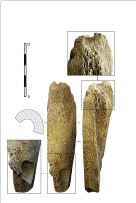

The outcomes of 3D digital analysis confirm the crucial role of this methodological approach in taphonomic study, offering new clues in PIMs (Projectile Impact Marks) archaeological identification and distinction from cut marks, carnivore tooth marks and corrosion cavities.The process of creating lithic tools took our hominin species millions of years to perfect. These data are interpreted as a result of the specific design of Late Epigravettian lithic projectiles. The morphometric analyses, based on the descriptive criteria developed from other recent studies, highlight the presence of peculiar features of experimentally produced drag and puncture marks. At the same time, the potential of 3D scanning microscopy to distinguish hunting injuries from other taphonomic marks is assessed. As such, this paper aims to provide comparison data for identifying archaeological Late Epigravettian projectile impact marks. Though recently there has been an increase in studies focused on this issue, no experimental works exist that analyze marks left by backed, morphologically standardized lithic projectiles like those used by the hunter-gatherers that peopled a large part of Europe during the Late Glacial. The search for diagnostic criteria useful in hunting lesions identification is a new branch of investigation. A brief comparative outline of the Banat Aurignacian settlements is also provided, followed by and attempt at placing the local Aurignacian into the European Early Upper Palaeolithic landscape." Preliminary thermoluminescence results point to an estimated age between 45 and 40 ka for the main accumulation in GH3 at Româneşti, thus indicating a possible contemporaneity of the Banat Aurignacian and the Oase AMH finds. Alongside the more accurate identification of the main technological and typological features, pointing to a Protoaurignacian/Early Aurignacian assignation of the Early Upper Palaeolithic industry here, new chronological landmarks, much older than previously considered, became available.

This study presents the attribute analysis of the Aurignacian lithic assemblage at Româneşti-Dumbrăviţa I, involving both old and recently excavated collections. The last find set the stage for new stratigraphic, chronological and archaeological reassessment of Banat Aurignacian settlements at Tincova, Coşava and Româneşti-Dumbrăviţa. "Previous archaeological research in the Banat area (South-western Romania) resulted in the definition of a chronologically late Krems-Dufour type Aurignacian, followed by the isolated find of several considerably old anatomically modern human (AMH) remains at Oase Cave, several decades later. The key changes involve a virtually complete rejection of an Aurignacian occurrence and an improved chronology of the Gravettian/Epigravettian technocomplex, now overtly related to several better documented sequences along the Prut and Dniestr rivers. A consistently revised chrono-cultural framework is proposed.

Based on a previous critical reassessment of the original lithic toolkits the present paper attempts at assembling the most important results recently obtained through new archeological researches in several settlements in the area (Poiana Cireșului, Bistricioara-Lutărie I and III, Bistricioara ‘La Mal’).

BP), involving its partial contemporaneity with the local Gravettian (24–16 ka BP). Various chronological data and cultural interpretations accumulated in the following decades granted the local Paleolithic some unusual features, such as the bizarrely young chronology of the Aurignacian technocomplex (27–21 ka uncal. The local Pleistocene geological archives hosted Aurignacian, Gravettian, Epigravettian and Swiderian layers. From the initial researches in the 1950’s, the geological and archeological sequences preserved on the Bistrița terraces have been constantly thought to provide a remarkably complete chronicle of the Upper Paleolithic in eastern Romania.


 0 kommentar(er)
0 kommentar(er)
